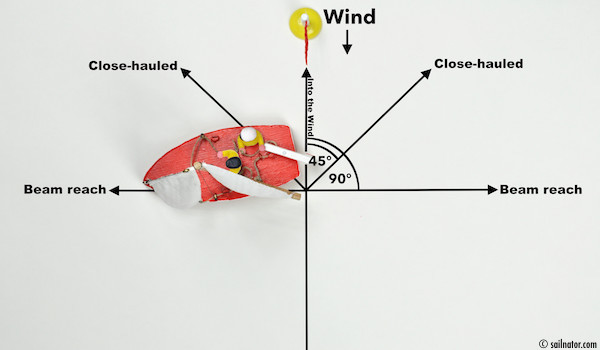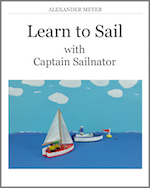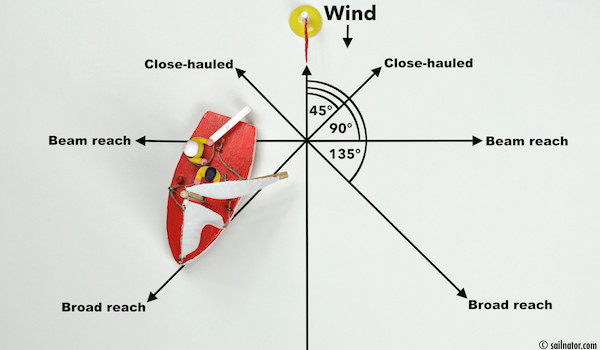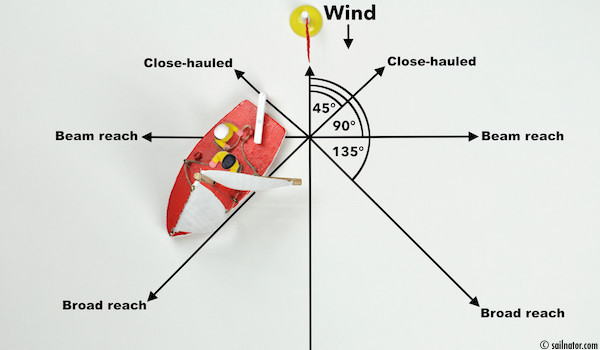In the last chapter we bore away from close-hauled to beam reach and learned how to trim the sails in the proper manner. Now we want to see what happens, when we go on to bear away.
How do we operate the tiller to bear away further … ? Right, we pull it towards us. The first thing we realise is that the boat no longer heels. We are moving from thrust by lift to thrust by resistance. The wind now comes diagonally from behind and no longer pushes the boat sideward anymore. The centreboard can be lifted now. We no longer need it to provide lateral pressure and to work against the drift. It would only slow down the boat. The position of the crew from now should be in the middle of the boat, even in stronger winds.

Figure 30: Command: “Ease sheets for broad reach!” while bearing away from beam reach!
What we realise as well in this moment is that we suddenly slow down. Why … ? We have not trimmed the sails properly yet. (To a sailor, sailing broad reach seems slower even with the sails trimmed properly, because the boat does not heel anymore and sailing is calmer.) What do we have to do with the sails when we bear away … ? Right, we have to ease them. But how far and how do we realise that we have already left broad reach and we have borne away too far?
 This online sailing course has also been published as ebook and paperback. For more information click here!
This online sailing course has also been published as ebook and paperback. For more information click here!
You can download the Ebook for example at:
iTunes UK & iTunes US | iBooks for iPad and Mac
Amazon.com & Amazon.co.uk | Kindle-Edition
Google Play | for Android
The paperback is available for example at:
Amazon.com | Amazon.co.uk
The jib has to be eased till it starts to luff. Then we haul it back till it fills again. The mainsail has to be opened wide, but not as wide as possible to do. It should not hit the shroud with boom or sail on this course. The sail has to be in a proper angle to the wind that now comes diagonally from behind in order to generate thrust by resistance.

Figure 31: Bear away till the jib collapses!
Doing so we keep on bearing away and in the meantime we watch the jib. At a certain point the jib will collapse, because it is now in the wind shadow of the mainsail. This sign tells us that we have borne away too far. (Figure 31)

Figure 32: Head up till the jib fills with wind again.
So we head up again by pushing the tiller away from us, till the jib fills with wind again. (Figure 32)

Figure 33: Command: “Sailing broad reach!”
As soon as we have found broad reach we now position the tiller in the middle. As usual to stay on course we find a prominent point on land (e.g. house, tree) that is in line with our bow and head towards it. (Figure 33) The commands for bearing away to broad reach are: “Ease sheets for broad reach!” and: “Sailing broad reach!”
Watch again my stop motion video about the points of sail with Jenny and Tom →
That was the point of sail broad reach. If we want to go back to beam reach we have to … ? Right, head up. And what do we have to do with the tiller … ? Exactly, we have to push it away. But what happens when we keep on bearing away from broad reach? That is what I will explain to you in the next chapter.
← Last chapter | Next chapter →
All chapters: Technical Terms | The theory behind sailing |Close-hauled | Beam reach | Broad reach | Sailing downwind | Tacking | Beating | Quick-turn | Sailing up head to wind | Man overboard | Jibing | Heaving-to | Leaving the dock | Berthing | Rules of the road 1 | Rules of the road 2 | Rules of the road 3 | Reefing | Capsizing